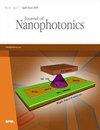Design and simulation of refractive index sensor based on suspended composite hybrid plasmonic waveguide for sensing mass density of polarizable hydrogen gas
IF 1.1
4区 物理与天体物理
Q4 NANOSCIENCE & NANOTECHNOLOGY
引用次数: 0
Abstract
Abstract. Hybrid plasmonic waveguides (HPWs) are capable of supporting subwavelength optical modes. In a composite HPW (CHPW), the propagation loss can be minimized by adjusting the geometrical parameters of its component layers to reduce field flux inside its lossy metal layer. A ring resonator-based plasmonic sensor based on a waveguide structure of suspended CHPW (SCHPW) is designed for gas sensing applications. SCHPWs are applied for the introduced sensor’s 200-nm-wide bus waveguide and 1-μm-radius ring resonator. The operational parameters of the sensor, such as sensitivity and figure of merit (FOM), are investigated in the near-infrared region using a three-dimensional finite-difference time-domain method. For two considered resonances of the proposed sensor, sensitivities of 236.2 and 270 nm / RIU with FOMs of 67.4 and 37.5 RIU − 1 are achieved, respectively. Additionally, for the proposed sensor, a straightforward mechanism for sensing the mass density of the polarizable hydrogen gas is introduced using the theoretical index–density relation of Lorentz–Lorenz. The mass density sensitivities of 358.2 and 409.3 nm / ( g / cm3 ) are achieved for the two considered resonances for the hydrogen gas at the range of 0 to 0.05 g / cm3.基于悬浮复合混合等离子体波导的可极化氢气质量密度折射率传感器设计与仿真
摘要混合等离子波导(HPWs)能够支持亚波长光模式。在复合HPW (CHPW)中,可以通过调整其组件层的几何参数来减小损耗金属层内的场通量,从而使传输损耗最小化。设计了一种基于悬浮CHPW波导结构的环形等离子体传感器,用于气体传感应用。该传感器的总线波导宽度为200nm,环形谐振腔半径为1 μm。利用三维时域有限差分法研究了传感器在近红外区域的工作参数,如灵敏度和性能值。对于所提出的传感器的两个考虑的共振,灵敏度分别为236.2和270 nm / RIU, fom分别为67.4和37.5 RIU−1。此外,对于所提出的传感器,利用洛伦兹-洛伦兹的理论指数-密度关系,介绍了一种直观的感应极化氢气质量密度的机制。在0 ~ 0.05 g / cm3范围内,所考虑的两种谐振的质量密度灵敏度分别为358.2和409.3 nm / (g / cm3)。
本文章由计算机程序翻译,如有差异,请以英文原文为准。
求助全文
约1分钟内获得全文
求助全文
来源期刊

Journal of Nanophotonics
工程技术-光学
CiteScore
2.60
自引率
6.70%
发文量
42
审稿时长
3 months
期刊介绍:
The Journal of Nanophotonics publishes peer-reviewed papers focusing on the fabrication and application of nanostructures that facilitate the generation, propagation, manipulation, and detection of light from the infrared to the ultraviolet regimes.
 求助内容:
求助内容: 应助结果提醒方式:
应助结果提醒方式:


